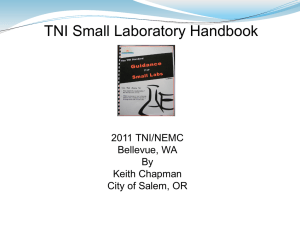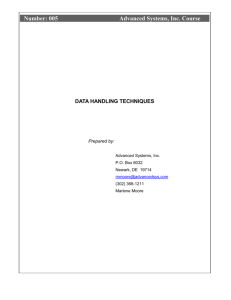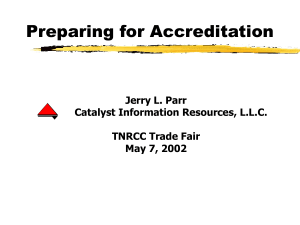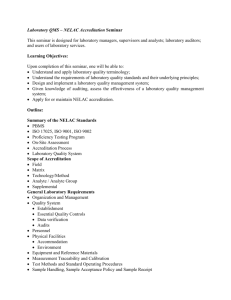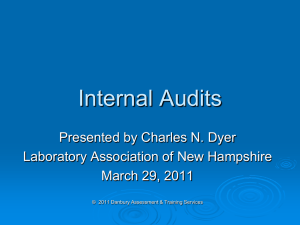Quality Systems Expert Committee
advertisement
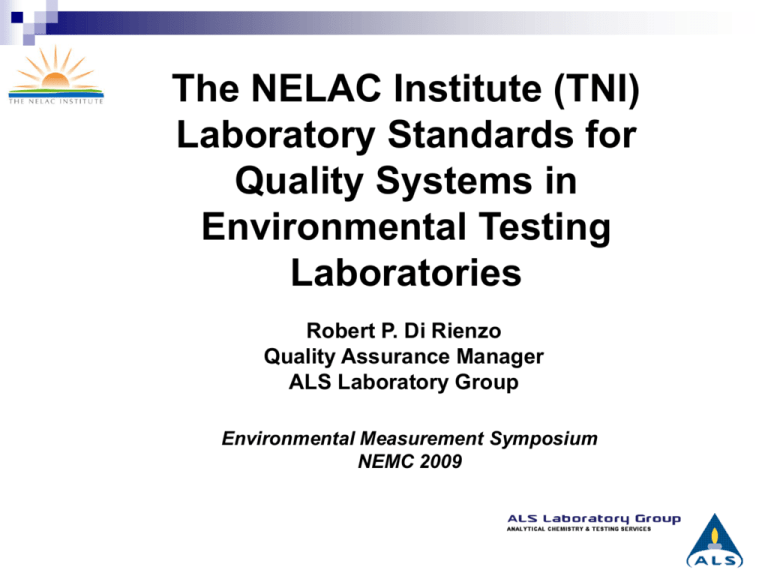
The NELAC Institute (TNI) Laboratory Standards for Quality Systems in Environmental Testing Laboratories Robert P. Di Rienzo Quality Assurance Manager ALS Laboratory Group Environmental Measurement Symposium NEMC 2009 What is Consensus? Consensus is a decision-making process that not only seeks the agreement of most participants, but also to resolve or mitigate the objections of the minority to achieve the most agreeable decision. What is a Standard? A standard is an established norm or requirement. It is usually a formal document that establishes uniform engineering or technical criteria, methods, processes and practices. TNI Quality Systems Expert Committee Accreditation Bodies: Aaren Alger, State of Pennsylvania Laurie Carhart, State of New York Michelle Potter, State of New Jersey Accredited Laboratories: Robin Cook, City of Daytona Beach Robert Di Rienzo, DataChem Laboratories Wilson Hershey, Lancaster Laboratories Paul Junio, Test America Other: Silky Labie, State of Florida Fred McLean, DoD Randy Querry, A2LA How does a laboratory know what to do? Will the laboratory every get it right? The TNI Standards are based on the concept of sectors, volumes, and modules. Environmental Laboratory Sector Volume 1 – Management and Technical Requirements for Laboratories Performing Environmental Analysis Module 1 – Proficiency Testing Module 2 – Quality Systems General Requirements Module 3 – Quality Systems for Asbestos Testing Module 4 – Quality Systems for Chemical Testing Module 5 – Quality Systems for Microbiological Testing Module 6 – Quality Systems for Radiochemical Testing Module 7 – Quality Systems for Toxicity Testing The TNI Standards are based on the concept of sectors, volumes, and modules. Environmental Laboratory Sector Volume 1 – Management and Technical Requirements for Laboratories Performing Environmental Analysis Module 1 – Proficiency Testing PT Testing Requirements for Laboratories Module 2 – Quality Systems: General Requirements Module 3 – Asbestos Testing Module 4 – Chemical Testing Module 5 – Microbiological Testing Module 6 – Radiochemical Testing Module 7 – Toxicity Testing The TNI Standards are based on the concept of sectors, volumes, and modules. Environmental Laboratory Sector Volume 1 – Management and Technical Requirements for Laboratories Performing Environmental Analysis Module 2 – Quality Systems General Requirements A Quality System for all laboratories Volume 1 Environmental Laboratory Sector Laboratories Requirements Module 2 - Quality Systems General Requirements • Format consistent with ISO 17025:2005 • Additional NELAC 2003 requirements follow applicable ISO sections • Specific technical requirements in Modules 3 to 7 Module 2 - Quality Systems General Requirements 1.0 INTRODUCTION, SCOPE AND APPLICABILITY Introduction and Scope 2.0 NORMATIVE REFERENCES 3.0 TERMS AND DEFINITIONS Additional Terms and Definitions, Definition Sources, and Exclusions and Exceptions Module 2 - Quality Systems General Requirements 4.0 MANAGEMENT REQUIREMENTS Organization, Management, Document Control, Review of Request, Tenders and Contracts, Subcontracting, Purchasing Services and Supplies, Service to the Client, Complaints, Control of Nonconforming Work, Improvement, Corrective Action, Preventive Action, Control of Records, Internal Audits, Management Review, and Data Integrity Surveillance Module 2 - Quality Systems General Requirements 5.0 TECHNICAL REQUIREMENTS General, Personnel, Accommodation and Environmental Conditions, Environmental Test Methods and Method Validation, Calibration Requirements, Measurement Traceability, Collection of Samples, Handling Samples and Test Items, Quality Assurance for Environmental Testing, and Reporting the Results Module 2 - Quality Systems General Requirements Example Section from Module 2 – Non ISO version 4.14 Internal Audits (ISO/IEC 17025:2005(E), Clause 4.14) ISO text 4.14.1 to 4.14.4 here 4.14.5 Additional Items a) The laboratory shall have a policy that specifies the time frame for notifying a client of events that cast doubt on the validity of the results. b) The laboratory management shall ensure that these actions are discharged within the agreed time frame. c) The internal audit schedule shall be completed annually. Major Changes from NELAC 2003 ISO 17025:2005 Changes Addition of section on Improvement (4.10) Management System = Quality System Summary of ISO Changes is available. Major Changes from NELAC 2003 NELAC 2003 Reorganization All Technical Requirements moved to Technical Modules Elements of Quality Manual in section 4.2.8 Calibration Requirements Major Changes from NELAC 2003 The Quality Manual 4.2.8 Additional Management System Requirements 4.2.8.3 The quality manual shall contain: a) document title; b) laboratory's full name and address; c) name, address of individual(s) responsible for the laboratory; Major Changes from NELAC 2003 The Quality Manual d) identification of all major organizational units and the effective date of the version; e) identification of the laboratory's approved signatories; f) the signed and dated concurrence of all responsible parties; Major Changes from NELAC 2003 The Quality Manual g) the objectives of the quality system and contain or reference the laboratory’s policies and procedures; h) the laboratory’s official quality policy statement and management’s commitment to ethical laboratory practices and to upholding the requirements of this Standard; and i) a table of contents, and applicable lists of references, glossaries and appendices. Major Changes from NELAC 2003 The Quality Manual 4.2.8.4 The quality manual shall contain or reference: a) all maintenance, calibration and verification procedures; b) major equipment and reference measurement standards used as well as the facilities and services used by the laboratory in conducting tests; c) verification practices, use of reference materials and internal quality control schemes; Major Changes from NELAC 2003 The Quality Manual d) procedures for reporting analytical results; e) the organization and management structure f) procedures to ensure that all records are retained and procedures for control and maintenance of documentation; Major Changes from NELAC 2003 The Quality Manual g) job descriptions; h) procedures for traceability; i) a list of all test methods; j) procedures for reviews all new work; k) procedures for handling samples; Major Changes from NELAC 2003 The Quality Manual l) procedures for corrective action when discrepancies are detected, or departures from documented policies and procedures occur; m) policy for permitting departures from documented policies and procedures; n) procedures for dealing with complaints; Major Changes from NELAC 2003 The Quality Manual o) procedures for protecting confidentiality; p) procedures for audits and data review; q) procedures for personnel experience and needed training; and r) policy addressing the use of unique electronic signatures. Major Changes from NELAC 2003 Calibration Requirements 5.5.13 Additional Requirements and Clarifications Calibration requirements for analytical support equipment are included in this Section while requirements for instrument (testing) calibration are included in technical modules (i.e., Asbestos, Chemistry, Microbiology, Radiochemistry and Toxicology). Major Changes from NELAC 2003 Additional Requirements NONE Significant Changes in Requirements No Arbitrary Expiration Dates Removes NELAC 2003 language and replaces with ISO 17025:2005 language, where applicable The TNI Standards are based on the concept of sectors, volumes, and modules. Environmental Laboratory Sector Volume 1 – Management and Technical Requirements for Laboratories Performing Environmental Analysis Module 1 – Proficiency Testing Module 2 – Quality Systems: General Requirements Module 3 – Quality Systems for Asbestos Testing Module 4 – Quality Systems for Chemical Testing Module 5 – Quality Systems for Microbiological Testing Module 6 – Quality Systems for Radiochemical Testing Module 7 – Quality Systems for Toxicity Testing Volume 1 Environmental Laboratory Sector Laboratories Requirements Modules 3 to 7 – Quality Systems for Asbestos, Chemical, Microbiological, Radiochemical, and Toxicological Testing • Specific to Testing Activity • Consistent Format and Structure in all Technical Modules Major Changes from NELAC 2003 NELAC 2003 Reorganization Combination of Requirements from NELAC 2003, Chapter 5 and Appendix C and D Format Consistent in all Technical Modules All Testing Requirement Related to Technology Support Equipment Requirements in Module 2 Major Changes from NELAC 2003 Major Items Initial Demonstration of Capability and Ongoing Demonstration of Capability Technical Requirements include: Calibration Quality Control Data Reduction Acceptance/Rejection Criteria Sample Handling Modules 3 to 7 – Quality Systems for Testing _____________TESTING 1.1 Introduction 1.2 Scope 1.3 Terms and Definitions Modules 3 to 7 – Quality Systems for Testing _____________TESTING 1.4 Method Selection 1.5 Method Validation Validation of Methods, Limit of Detection and Limit of Quantitation, Evaluation of Precisions and Bias, and Evaluation of Selectivity Modules 3 to 7 – Quality Systems for Testing _____________TESTING 1.6 Demonstration of Capability (DOC) General, Initial DOC, and Ongoing DOC 1.7 Technical Requirements Initial Calibration, Continuing Calibration, Quality Control for Chemistry, Data Reduction, Reagent Quality, Water Quality and Checks, Data Acceptance/Rejection Criteria, and Sample Handling Modules 3 to 7 - Example Section 1.6 1.6.1 Demonstration of Capability (DOC) General Prior to acceptance and institution of any method for which data will be reported, a satisfactory initial DOC is required (see Section 1.6.2). Thereafter, ongoing DOC (Section 1.6.3), as per the quality control requirements in Section 1.7.3 (such as laboratory control samples) is required. In cases where a laboratory analyzes samples using a method that has been in use by the laboratory for at least one year prior to applying for accreditation, and there have been no significant changes in instrument type, personnel or method, the ongoing DOC shall be acceptable. Modules 3 to 7 - Example Section 1.6 1.6.1 Demonstration of Capability (DOC) General (Continued) The laboratory shall have records on file to demonstrate that a DOC is not required. For the initial DOC, appropriate records as discussed in Section 1.6.2 shall be completed. An initial DOC shall be completed each time there is a change in instrument type, personnel, or method. All demonstrations shall be documented. All data applicable to the demonstration shall be retained and readily available at the laboratory. Major Changes from NELAC 2003 Demonstration of Capability 1.6.2 Initial DOC An initial DOC shall be conducted prior to using any test method, and at any time there is a change in instrument type, personnel or test method or any time that a method has not been performed by the laboratory or analyst in a twelve-month period. Major Changes from NELAC 2003 Demonstration of Capability 1.6.3 Ongoing DOC 1.6.3.1 The laboratory shall have a documented procedure describing ongoing DOC. The analyst(s) shall demonstrate on-going capability by meeting the quality control requirements of the method, laboratory SOP, client specifications, and/or this Standard. It is the responsibility of the laboratory to document that other approaches to ongoing DOC are adequate. Questions? Robert P. Di Rienzo Quality Assurance Manager ALS Laboratory Group, Environmental Division (Salt Lake City, UT) Bob.DiRienzo@alsenviro.com (801) 266-7700
